The Large Capacity Stationary Fuel Cell Market is estimated to be valued at USD 1.8 billion in 2025 and is projected to reach USD 5.5 billion by 2035, registering a compound annual growth rate (CAGR) of 12.0% over the forecast period. During the early adoption phase from 2020 to 2024, the market remains nascent, growing from USD 1.0 billion to USD 1.6 billion. This period is characterized by pilot projects, limited commercial deployment, and technology validation. Early adopters, including industrial and utility customers, begin experimenting with stationary fuel cell systems, creating foundational demand and proving the technology’s reliability and efficiency. The scaling phase spans 2025 to 2030, where the market grows rapidly from USD 1.8 billion in 2025 to around USD 2.8 billion in 2030.
Widespread commercial deployment, improved production capabilities, and declining costs drive this expansion. Strategic partnerships, government incentives, and corporate sustainability initiatives accelerate adoption. Companies focus on scaling manufacturing, securing supply chains, and expanding installation networks to meet growing demand efficiently. The consolidation phase occurs from 2030 to 2035, as the market reaches USD 5.5 billion. Growth moderates, competition intensifies, and the industry shifts toward operational efficiency, cost optimization, and differentiation through service offerings and technological improvements. Market leaders solidify positions, smaller players consolidate or exit, and standardized solutions emerge. The maturity curve highlights strategic inflection points for investment, expansion, and competitive positioning in this rapidly evolving clean energy sector.
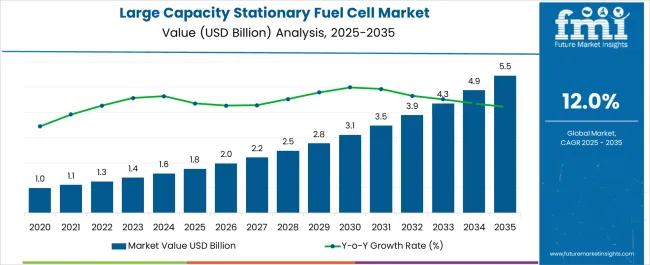
| Metric | Value |
|---|---|
| Large Capacity Stationary Fuel Cell Market Estimated Value in (2025 E) | USD 1.8 billion |
| Large Capacity Stationary Fuel Cell Market Forecast Value in (2035 F) | USD 5.5 billion |
| Forecast CAGR (2025 to 2035) | 12.0% |
The large capacity stationary fuel cell market is gaining traction due to rising energy reliability demands, decarbonization targets, and growing investments in distributed power generation. Increasing grid instability, along with the need for an uninterrupted power supply in critical infrastructure, has pushed enterprises and utilities to adopt high-capacity fuel cell systems.
These solutions provide consistent and low-emission power output while offering greater operational resilience and fuel flexibility. Advances in hydrogen fuel infrastructure, supportive regulatory frameworks, and incentives for clean energy deployment are further strengthening market dynamics.
As the global energy mix shifts toward cleaner and decentralized sources, large capacity stationary fuel cells are becoming central to sustainable energy transition strategies, particularly across data-intensive and commercial environments.
The large capacity stationary fuel cell market is segmented by capacity, application, end use, and geographic regions. By capacity, the large-capacity stationary fuel cell market is divided into three categories: 200 kW, 200 kW-1 MW, and ≥ 1 MW. In terms of application, the large-capacity stationary fuel cell market is classified into Commercial and Industrial. Based on end use, the large-capacity stationary fuel cell market is segmented into Data Centers, CHP, naval bases, Distribution centers, and Others. Regionally, the large-capacity stationary fuel cell industry is classified into North America, Latin America, Western Europe, Eastern Europe, the Balkan & Baltic Countries, Russia & Belarus, Central Asia, East Asia, South Asia & Pacific, and the Middle East & Africa.
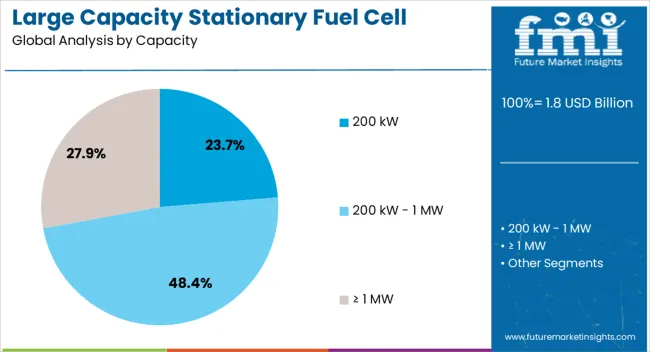
The 200 kW capacity segment is projected to represent 23.70% of total market revenue by 2025, positioning it as a significant category within capacity configurations. Its strong market position is driven by its suitability for mid scale facilities requiring reliable and independent power generation.
The segment is favored for its balance of footprint efficiency and power output, making it viable for small to medium enterprises, hospitals, and institutional facilities. Additionally, its ability to reduce reliance on diesel generators and minimize greenhouse gas emissions aligns with ESG compliance strategies.
As adoption grows across grid constrained and mission critical applications, this capacity segment continues to gain preference due to its cost efficiency and integration flexibility.
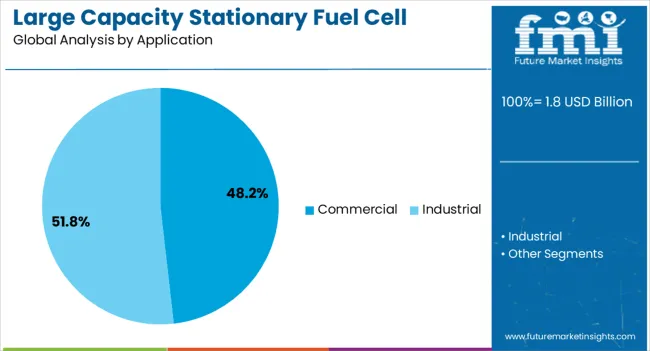
The commercial application segment is expected to account for 48.20% of overall revenue by 2025, establishing it as the leading application area. This dominance stems from the sector’s demand for uninterrupted, clean, and scalable energy solutions that support operational continuity.
Businesses are increasingly deploying large capacity fuel cells to ensure energy independence, meet sustainability goals, and reduce peak load pressure on public grids. The commercial sector benefits from fuel cell systems that offer both economic and environmental advantages, particularly in regions with high energy costs or stringent carbon regulations.
This consistent demand for reliable off-grid and supplementary power continues to reinforce the segment’s leadership position.
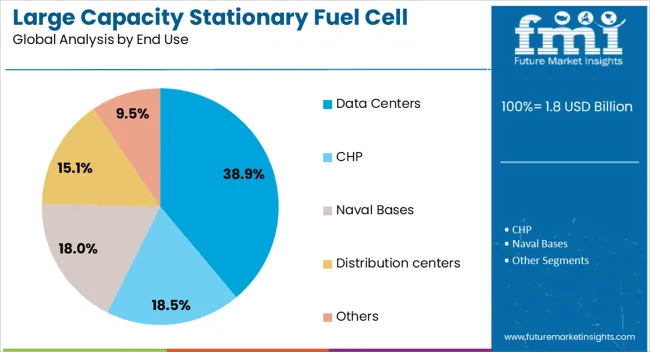
The data centers segment is projected to contribute 38.90% of market revenue by 2025, making it the top end use category. This growth is attributed to rising global data traffic, expansion of hyperscale facilities, and the need for ultra reliable and energy dense backup power systems.
Fuel cells offer a clean and space-efficient alternative to conventional diesel-based backup systems, reducing emissions and improving long-term cost efficiency. Data centers are increasingly integrating fuel cell systems to meet green certification standards, enhance uptime guarantees, and manage energy risks.
As digital infrastructure becomes more mission-critical, the demand for fuel cell-based energy solutions is expected to further accelerate, maintaining this segment’s dominant position in the market.
The large capacity stationary fuel cell market is growing steadily due to rising demand for clean, reliable, and efficient energy generation solutions. These fuel cells provide continuous power for industrial, commercial, and utility-scale applications while reducing greenhouse gas emissions. Increasing investments in renewable energy integration, government incentives, and decarbonization initiatives are driving adoption. Technological advancements in high-efficiency fuel cells, combined with better durability and lower operating costs, are enabling scalable deployment. North America, Europe, and Asia-Pacific are leading the market due to supportive energy policies and rising electricity demand. Market players focus on long-term service contracts, modular systems, and hybrid integration with solar or wind. Strategic collaborations, research partnerships, and enhanced performance monitoring are enhancing competitiveness and fostering large-scale adoption across industrial, commercial, and utility sectors.
One of the key challenges for large capacity stationary fuel cells is the high upfront capital cost. Fuel cell systems require expensive catalysts, membranes, and ancillary components, making initial investments substantial. Operational expenses, including hydrogen or natural gas supply, system maintenance, and replacement of key components, further add to lifecycle costs. Scaling systems to meet industrial or utility-level power requirements often necessitates customized solutions, increasing engineering and deployment expenses. Financing models and government incentives are crucial to improve affordability. Additionally, achieving consistent performance and long-term durability under varying load conditions is a technical challenge that affects cost efficiency. Companies investing in cost optimization, modular designs, and hybrid integration with renewable sources can reduce total cost of ownership and enhance adoption in commercial, industrial, and utility-scale applications.
Technological innovations are driving performance improvements in stationary fuel cells. Developments in high-temperature fuel cells, solid oxide fuel cells (SOFCs), and proton exchange membrane (PEM) fuel cells improve energy efficiency, power density, and operational reliability. Integration with energy storage systems and hybridization with renewables enhances grid stability and energy management. Advanced materials and catalyst optimization reduce degradation rates, extend system lifespan, and improve overall efficiency. Real-time monitoring, predictive maintenance, and digital twin technologies enhance operational reliability for industrial-scale applications. These innovations are enabling flexible load management and scalability for diverse applications, from industrial facilities to microgrids. Companies leveraging advanced technologies gain a competitive edge by offering high-performance, low-maintenance solutions that meet stringent energy efficiency and environmental standards, fostering widespread adoption in stationary power markets.
The adoption of large capacity stationary fuel cells is strongly influenced by government regulations and energy policies. Incentives, subsidies, and tax credits for clean energy systems encourage deployment, while stringent emission regulations drive industries to adopt low-carbon power solutions. However, regulatory variability across regions can impact planning and investment decisions. Safety standards, hydrogen storage regulations, and grid interconnection requirements must be met for large-scale installations. Policy support for renewable integration and decarbonization further shapes market growth. Companies aligning with local energy codes, emission reduction mandates, and safety standards gain smoother market entry. Until uniform policies and global standards are established, regional differences in incentives, safety compliance, and permitting processes will continue to influence adoption speed and market expansion in stationary fuel cell applications.
The large capacity stationary fuel cell market is competitive, with manufacturers, technology providers, and energy integrators vying for contracts. Supply chain dynamics, including catalyst availability, membrane production, and high-purity hydrogen supply, influence system scalability and cost. Partnerships with renewable energy providers, utilities, and industrial clients are crucial for project implementation and long-term service contracts. Emerging players focus on cost-effective modular systems, while established companies leverage performance, reliability and service networks. Geopolitical factors, raw material sourcing, and manufacturing lead times affect market stability. Companies investing in vertically integrated production, local component sourcing, and strategic alliances strengthen supply chain resilience. Until standardized fuel cell components and supply networks are widespread, competition will remain centered on technological differentiation, reliability, cost optimization, and the ability to deliver large-scale, uninterrupted power solutions.

| Countries | CAGR |
|---|---|
| China | 16.2% |
| India | 15.0% |
| Germany | 13.8% |
| France | 12.6% |
| UK | 11.4% |
| USA | 10.2% |
| Brazil | 9.0% |
The global Large Capacity Stationary Fuel Cell Market is projected to grow at a CAGR of 12.0% through 2035, supported by increasing demand across industrial, commercial, and utility-scale power generation applications. Among BRICS nations, China has been recorded with 16.2% growth, driven by large-scale deployment and utilization in stationary power systems, while India has been observed at 15.0%, supported by rising adoption in industrial and commercial energy solutions. In the OECD region, Germany has been measured at 13.8%, where production and deployment for industrial and commercial power generation have been steadily maintained. The United Kingdom has been noted at 11.4%, reflecting consistent use in stationary energy systems, while the USA has been recorded at 10.2%, with production and utilization across industrial and utility-scale applications being steadily increased. This report includes insights on 40+ countries; the top five markets are shown here for reference.
The large capacity stationary fuel cell market in China is projected to grow at a CAGR of 16.2%, driven by rising industrial power demand and the push for clean energy solutions. Fuel cells provide reliable, continuous power for commercial, industrial, and utility-scale applications while supporting China’s carbon reduction goals. Technological advancements, including higher efficiency, longer lifespan, and better system integration, are enhancing market adoption. Government incentives, policies supporting hydrogen infrastructure, and investments in renewable energy accelerate deployment. Industrial facilities, data centers, and critical infrastructure increasingly rely on stationary fuel cells to ensure uninterrupted operations while minimizing emissions. Collaborative projects between energy providers and technology companies further expand market penetration. With China emphasizing sustainable energy and energy security, the demand for large capacity stationary fuel cells is expected to rise steadily.
India’s large capacity stationary fuel cell market is expanding at a CAGR of 15.0%, supported by growing industrialization and energy security needs. Stationary fuel cells are increasingly used in commercial and industrial facilities for continuous, low-emission power supply. Government initiatives promoting hydrogen infrastructure, renewable energy, and low-carbon technologies drive market growth. Technological innovations, such as improved fuel cell stacks, energy management systems, and modular designs, enhance operational efficiency and reliability. Collaborative efforts between domestic and international technology providers enable broader deployment across manufacturing hubs and commercial establishments. With India targeting carbon neutrality and sustainable energy adoption, stationary fuel cells are expected to play a significant role in the country’s energy transition.
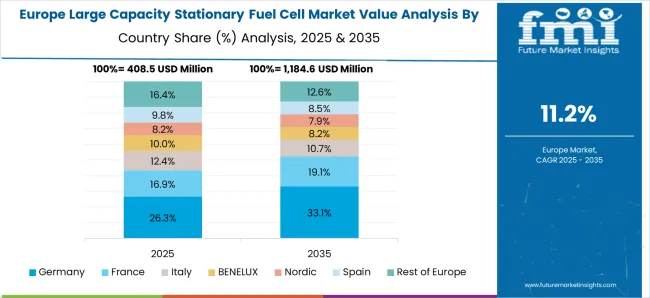
Germany’s large capacity stationary fuel cell market is projected to grow at a CAGR of 13.8%, driven by industrial demand, environmental regulations, and renewable energy targets. Fuel cells are increasingly adopted in manufacturing plants, commercial buildings, and critical infrastructure to ensure reliable, low-emission power supply. Technological improvements, including higher system efficiency, durability, and integration with hydrogen networks, support adoption. Government initiatives promoting decarbonization, hydrogen technology, and industrial sustainability accelerate market growth. Industrial collaborations and R&D projects further strengthen deployment and commercialization. Germany’s focus on regulatory compliance and sustainable energy ensures steady growth of large capacity stationary fuel cells in industrial and commercial applications.
The UK large capacity stationary fuel cell market is growing at a CAGR of 11.4%, with adoption driven by industrial, commercial, and utility applications. Stationary fuel cells provide reliable, low-carbon power for data centers, manufacturing facilities, and critical infrastructure. Government programs supporting hydrogen infrastructure, renewable energy, and carbon reduction encourage deployment. Technological advancements in efficiency, durability, and system integration enhance operational performance. Pilot projects, industrial collaborations, and public-private initiatives are accelerating market adoption. As energy security and sustainability become increasingly important, the UK stationary fuel cell market is expected to grow steadily, supporting national renewable energy and decarbonization goals.
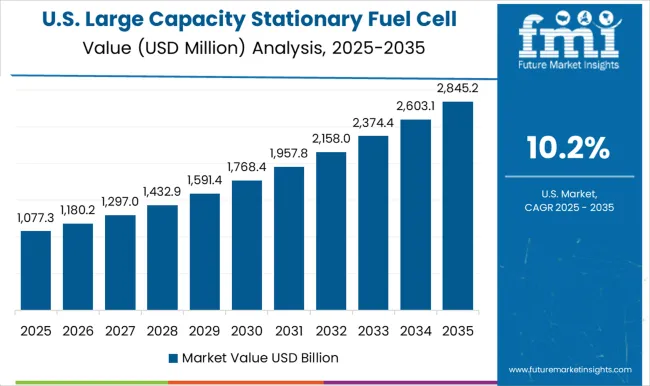
The USA large capacity stationary fuel cell market is projected to expand at a CAGR of 10.2%, fueled by industrial, commercial, and utility sector adoption. Stationary fuel cells provide reliable, continuous power with reduced emissions, meeting regulatory and sustainability requirements. Government policies encouraging hydrogen technology, renewable energy integration, and carbon reduction support market growth. Technological innovations, including improved efficiency, modularity, and system integration, enhance performance and lower operational costs. Industrial partnerships and R&D investments accelerate adoption in manufacturing plants, commercial facilities, and critical infrastructure. With increasing emphasis on energy security, sustainability, and low-carbon solutions, the USA market for large capacity stationary fuel cells is expected to experience steady growth.
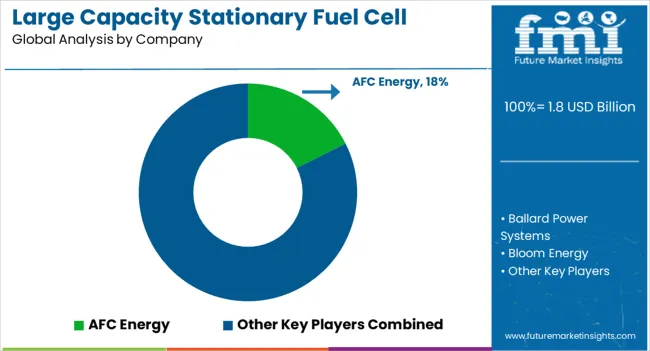
The large capacity stationary fuel cell market is witnessing rapid growth as industries and utilities seek efficient, low-emission, and reliable power solutions. Stationary fuel cells convert hydrogen or other fuels into electricity through electrochemical reactions, providing clean, continuous energy for commercial, industrial, and utility-scale applications. AFC Energy specializes in alkaline fuel cell solutions designed for high-capacity power generation, emphasizing modular and scalable systems.
Ballard Power Systems provides proton exchange membrane (PEM) fuel cells with robust performance for industrial and utility-scale installations. Bloom Energy is known for its solid oxide fuel cell (SOFC) technology, offering high-efficiency electricity generation for commercial and industrial sites. Doosan Fuel Cell America delivers fuel cell power plants tailored for continuous operation in critical facilities, combining durability with environmental benefits. E.ON integrates stationary fuel cells into broader energy management and smart grid solutions, supporting decarbonization initiatives. FuelCell Energy, Inc. focuses on high-capacity molten carbonate and alkaline fuel cells, catering to industrial energy demands. Companies such as Hanwa Energy, HyAxiom, and TW Horizon Fuel Cell Technologies provide modular solutions for diverse applications, while Honda, Toyota, and Panasonic leverage their automotive fuel cell expertise for stationary systems. Intelligent Energy develops compact, high-performance fuel cells suitable for distributed power generation. Nedstack Fuel Cell Technology BV and SOLIDpower offer PEM and SOFC systems optimized for large-scale deployment. Plug Power Inc. supports integrated hydrogen fuel cell solutions, including production, storage, and stationary power applications. Collectively, these manufacturers are driving innovation, efficiency, and sustainability in large-capacity stationary fuel cells, enabling industries to reduce carbon emissions while ensuring a reliable, continuous energy supply.
| Item | Value |
|---|---|
| Quantitative Units | USD 1.8 Billion |
| Capacity | 200 kW, 200 kW - 1 MW, and ≥ 1 MW |
| Application | Commercial and Industrial |
| End Use | Data Centers, CHP, Naval Bases, Distribution centers, and Others |
| Regions Covered | North America, Europe, Asia-Pacific, Latin America, Middle East & Africa |
| Country Covered | United States, Canada, Germany, France, United Kingdom, China, Japan, India, Brazil, South Africa |
| Key Companies Profiled | AFC Energy, Ballard Power Systems, Bloom Energy, Doosan Fuel Cell America, E.ON, FuelCell Energy, Inc., Hanwa Energy, Honda, HyAxiom, Inc., Intelligent Energy, Nedstack Fuel Cell Technology BV, Panasonic Corporation, Plug Power Inc., SOLIDpower, Toyota, and TW Horizon Fuel Cell Technologies |
| Additional Attributes | Dollar sales vary by fuel cell type, including proton exchange membrane (PEM), solid oxide fuel cells (SOFC), molten carbonate fuel cells (MCFC), and phosphoric acid fuel cells (PAFC); by power capacity, spanning medium (100 kW–1 MW), large (1–5 MW), and ultra-large (>5 MW) systems; by application, such as commercial buildings, industrial facilities, data centers, and microgrids; by region, led by North America, Europe, and Asia-Pacific. Growth is driven by increasing adoption of clean and reliable energy solutions, government incentives for low-carbon technologies, expansion of distributed power generation, rising demand for backup and continuous power in critical applications, and advancements in fuel cell efficiency and durability. |
The global large capacity stationary fuel cell market is estimated to be valued at USD 1.8 billion in 2025.
The market size for the large capacity stationary fuel cell market is projected to reach USD 5.5 billion by 2035.
The large capacity stationary fuel cell market is expected to grow at a 12.0% CAGR between 2025 and 2035.
The key product types in large capacity stationary fuel cell market are 200 kw, 200 kw - 1 mw and ≥ 1 mw.
In terms of application, commercial segment to command 48.2% share in the large capacity stationary fuel cell market in 2025.






Our Research Products

The "Full Research Suite" delivers actionable market intel, deep dives on markets or technologies, so clients act faster, cut risk, and unlock growth.

The Leaderboard benchmarks and ranks top vendors, classifying them as Established Leaders, Leading Challengers, or Disruptors & Challengers.

Locates where complements amplify value and substitutes erode it, forecasting net impact by horizon

We deliver granular, decision-grade intel: market sizing, 5-year forecasts, pricing, adoption, usage, revenue, and operational KPIs—plus competitor tracking, regulation, and value chains—across 60 countries broadly.

Spot the shifts before they hit your P&L. We track inflection points, adoption curves, pricing moves, and ecosystem plays to show where demand is heading, why it is changing, and what to do next across high-growth markets and disruptive tech

Real-time reads of user behavior. We track shifting priorities, perceptions of today’s and next-gen services, and provider experience, then pace how fast tech moves from trial to adoption, blending buyer, consumer, and channel inputs with social signals (#WhySwitch, #UX).

Partner with our analyst team to build a custom report designed around your business priorities. From analysing market trends to assessing competitors or crafting bespoke datasets, we tailor insights to your needs.
Supplier Intelligence
Discovery & Profiling
Capacity & Footprint
Performance & Risk
Compliance & Governance
Commercial Readiness
Who Supplies Whom
Scorecards & Shortlists
Playbooks & Docs
Category Intelligence
Definition & Scope
Demand & Use Cases
Cost Drivers
Market Structure
Supply Chain Map
Trade & Policy
Operating Norms
Deliverables
Buyer Intelligence
Account Basics
Spend & Scope
Procurement Model
Vendor Requirements
Terms & Policies
Entry Strategy
Pain Points & Triggers
Outputs
Pricing Analysis
Benchmarks
Trends
Should-Cost
Indexation
Landed Cost
Commercial Terms
Deliverables
Brand Analysis
Positioning & Value Prop
Share & Presence
Customer Evidence
Go-to-Market
Digital & Reputation
Compliance & Trust
KPIs & Gaps
Outputs
Full Research Suite comprises of:
Market outlook & trends analysis
Interviews & case studies
Strategic recommendations
Vendor profiles & capabilities analysis
5-year forecasts
8 regions and 60+ country-level data splits
Market segment data splits
12 months of continuous data updates
DELIVERED AS:
PDF EXCEL ONLINE
Fuel Cell for Stationary Power Market Growth - Trends & Forecast 2025 to 2035
Fuel Cell Powertrain Market Size and Share Forecast Outlook 2025 to 2035
Fuel Cell UAV Market Size and Share Forecast Outlook 2025 to 2035
Fuel Cell Stack Market Size and Share Forecast Outlook 2025 to 2035
Fuel Cell Electric Vehicle Market Size and Share Forecast Outlook 2025 to 2035
Fuel Cell Commercial Vehicle Market Size and Share Forecast Outlook 2025 to 2035
Fuel Cell Market Growth – Trends & Forecast 2025 to 2035
Fuel Cell for Data Center Market - Trends & Forecast 2025 to 2035
PEM Fuel Cell Market Size and Share Forecast Outlook 2025 to 2035
Hydrogen Fuel Cell Vehicle Market Size and Share Forecast Outlook 2025 to 2035
Portable Fuel Cells Market
Transport Fuel Cell Market Size and Share Forecast Outlook 2025 to 2035
Anaplastic Large Cell Lymphoma (ALCL) Therapeutics Market Size and Share Forecast Outlook 2025 to 2035
Solid Oxide Fuel Cell Market
Bipolar Plate Market Growth – Trends & Forecast 2024-2034
Direct Methanol Fuel Cell Market Size and Share Forecast Outlook 2025 to 2035
Perfluorosulfonic Acid Fuel Cell Proton Membrane Market Size and Share Forecast Outlook 2025 to 2035
Large-flow Horizontal Sand Mill Market Size and Share Forecast Outlook 2025 to 2035
Cellulose Diacetate Film Market Size and Share Forecast Outlook 2025 to 2035
Fuel rail for CNG Systems Market Size and Share Forecast Outlook 2025 to 2035

Thank you!
You will receive an email from our Business Development Manager. Please be sure to check your SPAM/JUNK folder too.
Chat With
MaRIA